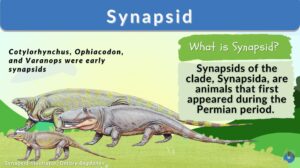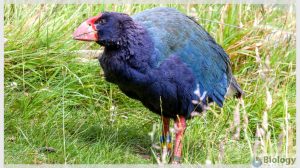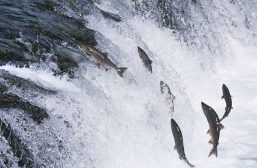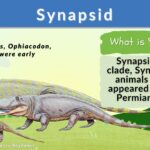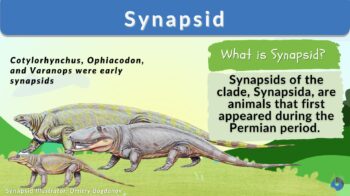
Synapsid
n., plural: synapsids
[sɪˈnapsɪd]
Definition: Common name for animals belonging to the clade Synapsida
Table of Contents
Any member of the Synapsida clade of animals is referred to as a synapsid. They are believed to have descended from the earliest amniotes. Their front teeth are distinct from their back teeth, they have limbs under the body, and they have a temporal fenestra (the temporal aperture on the sides of the skull).
Linnaean And Cladistic Classifications
Synapsids were regarded to be one of the four major reptile subclasses at the turn of the twentieth century and part of vertebrate paleontology. However, a deeper examination of skeletal remains contradicted this theory, as synapsids are distinguished from reptiles by their characteristic temporal apertures. These holes in the skull bones allowed for the attachment of larger jaw muscles, resulting in a more efficient bite.
Synapsids were later thought to be a later reptilian lineage that mammals evolved into by gradually gaining increasingly mammalian characteristics, hence the moniker “mammal-like reptiles” (pelycosaurs). These became the accepted names for all Paleozoic early synapsids. Reptiles are currently classified inside Sauropsida (sauropsids), the sister group to synapsids, giving synapsids their own taxonomic category.
As a result, in technical literature, the paraphyletic words “mammal-like reptile” and “pelycosaur” are considered archaic and disfavored, and the phrase stem mammal (or sometimes protomammal or para mammal) is used instead. Synapsids now form a separate branch of the tree of life, according to phylogenetic analysis.
The monophyly of Synapsida is undeniable, and phrases like “Synapsida contains the mammals” and “Synapsids gave rise to the mammals” both convey the same evolutionary idea. This language mirrors the present cladistical approach to animal connections, which holds that the only valid groups are those that have all descendants of a common ancestor: these are referred to as monophyletic groups or clades.
Furthermore, Reptilia (reptiles) has been revised into a monophyletic group that is wholly separate from Synapsida, falling under Sauropsida, Synapsida’s sister group within Amniota.
Watch this vid about synapsid:
Biology definition:
A synapsid refers to any animal belonging to the clade group Synapsida. Synapsids are believed to have descended from the earliest amniotes. Their front teeth are distinct from their back teeth, they have limbs under the body, and they have a temporal fenestra (the temporal aperture on the sides of the skull). These animals first appeared in the late Permian period (299 to 251 million years ago). They are presumed to have evolved from the basal amniotes. Mammal-like synapsids are now referred to as stem mammals or proto-mammals. Many of them became extinct by the Permian-Triassic extinction. Those that survived led to more advanced therapsids. Cynodonts including Mammaliaformes were the only synapsids to survive after the Triassic period.
Primitive and advanced synapsids
For simplicity, the synapsids are typically separated between therapsids, advanced synapsids and the branch from which living mammals developed, and stem mammals (formerly known as pelycosaurs), which include the other six more primitive synapsid families.
Therapsids possessed a more upright posture and, in some forms, hair, whereas stem mammals were entirely lizard-like, with sprawling gaits and potentially horny scutes. Traditional taxonomy divides the Synapsida into two groups: low-slung stem mammals gave rise to more erect therapsids, which, in turn, gave rise to mammals. In traditional vertebrate classification, stem mammals and therapsids were both considered orders of the category Synapsida.
Practical versus phylogenetic usage of “synapsid” and “therapsid”
The names are used slightly differently in phylogenetic nomenclature since the daughter clades are included. The term “Pelycosaur” has been used in most articles published in the twenty-first century to refer to an informal grouping of prehistoric members. Therapsida is still used as a clade that includes both classical therapsid groups and mammals.
Although modern mammals are included in Synapsida and Therapsida, in practice, those two words are almost solely used to refer to the more basic animals that sit outside of Mammaliaformes.
Characteristics
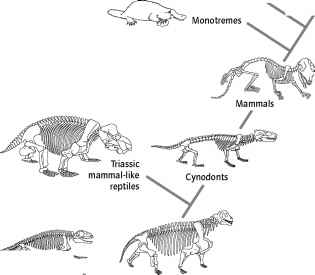
Below are some of the common characteristics of synapsids.
Temporal openings
On the lateral surface of the skull, synapsids evolved a temporal fenestra behind each eye orbit. It could have offered new attachment points for jaw muscles. A similar evolution occurred with diapsids, which evolved two rather than one aperture behind each eye.
The sphenoid bone has extended in higher therapsids and mammals to shut the openings in the skull, which were once only covered by the jaw muscles. As a result, the lower margin of the hole has formed an arch extending from the lower edges of the braincase.
Teeth
Synapsids have distinct teeth. These include the canines, molars, and incisors. Some labyrinthodonts and early anapsid reptilians have a trend toward differentiation in the form of elongation of the initial teeth on the maxilla, resulting in proto-canines.
This feature was later lost in the diapsid line but evolved further in the synapsids. Early mammals like synapsids could have two or three larger “canines,” but by therapsids, the pattern had resolved to one canine in each upper jaw half. Lower canines appeared later.
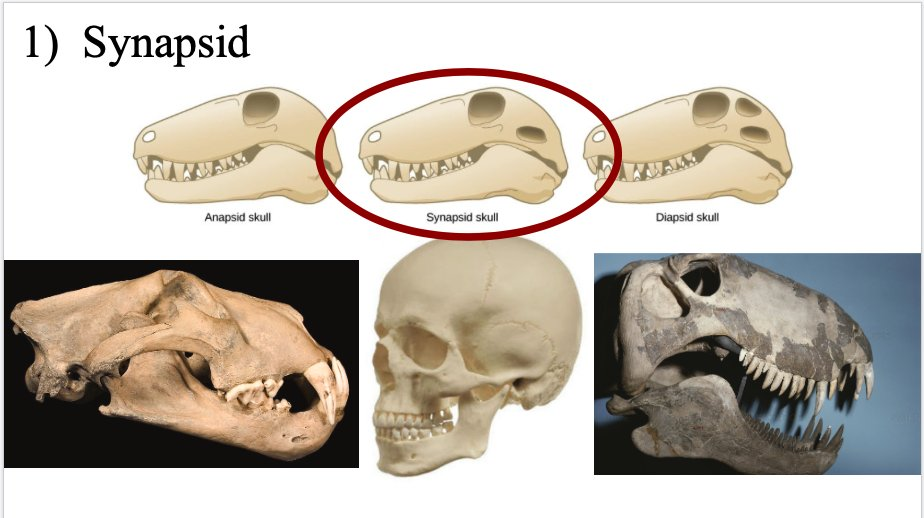
Jaw
The jaw transition is a useful categorization technique since it is followed by most other fossilized traits that create a chronological progression from a reptile-like to a mammalian condition. In mammals, the mandible, or lower jaw, is made up of a single tooth-bearing bone (the dentary), whereas in current and prehistoric reptiles, the lower jaw is made up of a conglomeration of smaller bones (including the dentary, articular, and others).
These jaw bones were reduced in size and either lost or, in the case of the articular, gradually moved into the ear, forming one of the middle ear bones: whereas modern mammals have the malleus, incus, and stapes, basal synapsids (like all other tetrapods) have only a stapes. The malleus is a descendant of the articular (a lower jaw bone), whereas the incus is a descendant of the quadrate (a cranial bone).
The dentary-squamosal jaw joint is another feature that distinguishes mammalian jaw architecture. The dentary connects with a dip in the squamosal known as the glenoid cavity in this type of jaw joint.
All other jawed vertebrates, including reptiles and nonmammalian synapsids, have an articular-quadrate jaw joint, in which one of the smaller bones of the lower jaw, the articular, connects with a bone of the cranium termed the quadrate bone to form the articular-quadrate jaw joint.
The jaw joint in transitional fossils is made up of a massive lower jaw bone (quite identical to dentary found in mammals) that does not link to the squamosal but instead connects to the quadrate through a receding articular bone.
Palate
Synapsids began to develop a secondary palate, which divided the mouth from the nasal cavity, as they evolved into more mammalian and less reptilian creatures. A secondary palate began to emerge on the sides of the maxilla in early synapsids, although the mouth and nostril remained united.
The two sides of the palate eventually started to curve together, giving a U shape rather than a C shape. Additionally, the palate began to expand back toward the throat, securing the entire mouth and forming a full palatine bone. The maxilla is totally closed as well.
Skin and fur
Aside from the glandular skin covered in fur found in most modern mammals, synapsids have a variety of modified skin coverings, including osteoderms, scutes, hair or fur, and scale-like structures. Reptile skin is rather thin, but mammalian skin has a substantial dermal layer.
The ancestors’ skin type of synapsids has been debated. Only two small varanopid species have been found to have scutes among the early synapsid mammals; fossilized rows of osteoderms imply horny armor on the neck and back, and skin impressions show some had rectangular scutes on their undersides and tails.
Mammary glands
Early synapsids may have laid parchment-shelled (leathery) eggs without a calcified covering, as most current reptiles and monotremes do. This could also explain why no fossil evidence of synapsid eggs has been found yet. Secretions from apocrine-like glands may have kept the eggs moist because they were susceptible to desiccation.
These glands would later evolve into real mammary glands with multiple modalities of secretion in conjunction with hair follicles. Comparative investigations of milk constituent evolutionary origins support the notion that secretions from these glands evolved into complex, nutrient-rich milk long before real mammals appeared.
Cynodonts were almost certainly capable of producing this, allowing for a gradual decline in yolk mass and thus egg size, resulting in increasingly altricial hatchlings as milk (placental mammals) became the principal source of sustenance, as demonstrated by tiny body size, the existence of epipubic bones, and restricted tooth replacement in advanced cynodonts and mammaliaforms.
Patagia
The aerial movement originally appeared in non-mammalian haramiyidan cynodonts, such as Arboroharamiya, Xianshou, Maiopatagium, and Vilevolodon, which had fur-covered wing membranes that stretch across the limbs and tail.
Their fingers are extended, similar to those of bats and colugos, and they are thought to have similar functions as wing supports and as a means of hanging from tree branches.
Volaticotherian eutriconodonts are the earliest known mammals to exhibit aerial mobility. A fossil Volaticotherium possesses a wonderfully preserved fuzzy patagium with tiny wrinkles that is quite extensive, “sandwiching” the badly preserved hands and feet and extending all the way to the base of the tail. Very closely related, Argentoconodon, has a comparable femur adapted to flying stresses, indicating a similar lifestyle.
Therian mammals would not attain powered flight and gliding until long after these early aeronauts had died out, with the first-known gliding metatherians and bats developing in the Paleocene.
Metabolism
Endothermy was discovered to have evolved as early as Ophiacodon in the late Carboniferous. The discovery of fibrolamellar bone, a specialized type of bone that can grow quickly while keeping a stable structure, indicates that Ophiacodon exploited its high internal body temperature to fuel rapid development comparable to modern endotherms.
Evolutionary History
The evolutionary history starts with the earliest-known synapsids, Asaphestera, Archaeothyris, and Clepsydrops, which lived in the Carboniferous period’s Pennsylvanian subperiod (323-299 mya) and were one of many types of primitive synapsids that are now classified as stem mammals or sometimes as protomammals.
Early synapsids expanded and evolved until they eventually outgrew all other terrestrial vertebrates, growing as long as 6 meters (20 feet) between the Late Carboniferous period and Early Permian periods. They were broad-shouldered, hefty, potentially cold-blooded, and had small brains.
The size of herbivores and carnivores varied, from tiny rodent-sized species to massive, hulking herbivores weighing a ton or more. After flourishing for millions of years, these successful species were nearly wiped out by the Permian-Triassic period mass extinction around 250 million years ago, the largest known extinction in Earth’s history (causing extinct species and extinct groups like the extinct synapsids and extant mammals), which was presumably caused by the Siberian Traps volcanic eruption.
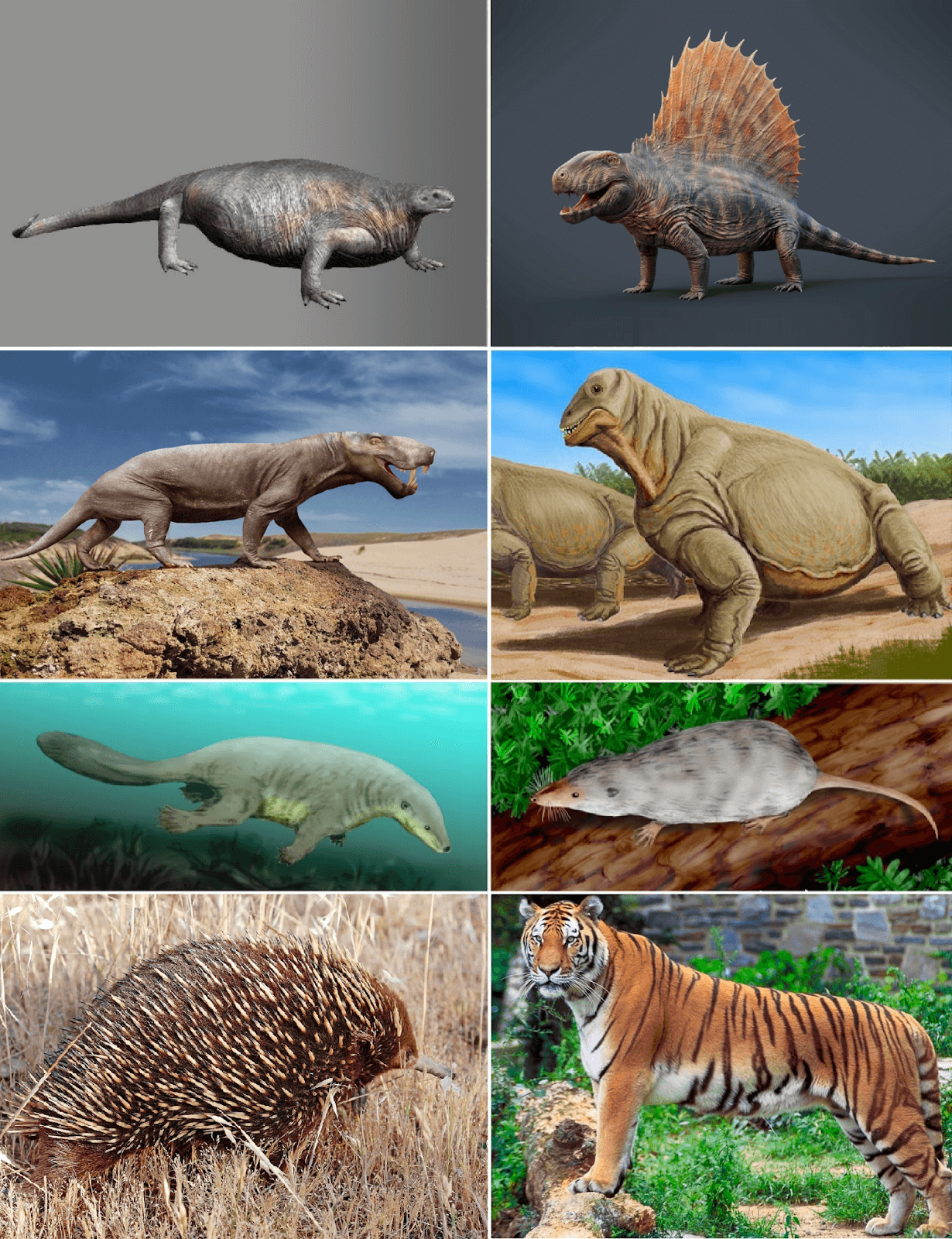
Relationships
The oldest synapsids, including taxa commonly categorized as Pelycosauria, are where the group’s phylogenetic tree is most ambiguous. Brinkman and Eberth (1983) identified the family Varanopidae as the most basic branch of the synapsid lineage. Brinkman and Eberth (1983) identified the family Varanopidae with Caseasauria as the most basic offshoot of the synapsid lineage in one of the earliest phylogenetic investigations.
Varanopidae was removed from Caseasauria by Reisz (1986), who relocated it to a more derived position on the stem. While most studies place Caseasauria as the most basal synapsid clade, Benson’s (2012) study identified Ophiacodontidae and Varanopidae as the most basal synapsids, with Caseasauria in a more derived position.
Benson ascribed the revised phylogeny to the addition of postcranial traits, or skeleton features other than the skull, in his research. Caseasauria remained the most basic synapsid group when only cranial or skull traits were considered.
NOTE IT!
Did you know…?
One of the two main subgroups of amniotes is the synapsids. The Sauropsida is the sibling group that gave origin to reptiles.
Take the Synapsid – Biology Quiz!
References
- Ancestry of mammalian “warm-bloodedness” revealed. (n.d.). ScienceDaily. Retrieved May 8, 2023, from https://www.sciencedaily.com/releases/2015/10/151029134252.htm
- Klembara, J., Hain, M., Ruta, M., Berman, D. S., Pierce, S. E., & Henrici, A. C. (2020). Inner ear morphology of diadectomorphs and seymouriamorphs (Tetrapoda) uncovered by high-resolution x-ray microcomputed tomography, and the origin of the amniote crown group. Palaeontology, 63(1), 131–154. https://doi.org/10.1111/pala.12448
- Larson, D. (2023, January 2). Synapsids—Fossil Classification. Fossil Hunters. https://www.fossilhunters.xyz/fossil-classification/synapsids.html
- Luo, Z.-X., Meng, Q.-J., Grossnickle, D. M., Liu, D., Neander, A. I., Zhang, Y.-G., & Ji, Q. (2017). New evidence for mammaliaform ear evolution and feeding adaptation in a Jurassic ecosystem. Nature, 548(7667), 326–329. https://doi.org/10.1038/nature23483
- Meng, Q.-J., Grossnickle, D. M., Liu, D., Zhang, Y.-G., Neander, A. I., Ji, Q., & Luo, Z.-X. (2017). New gliding mammaliaforms from the Jurassic. Nature, 548(7667), 291–296. https://doi.org/10.1038/nature23476
- Modesto, S. P., & Anderson, J. S. (2004). The phylogenetic definition of reptilia. Systematic Biology, 53(5), 815–821. https://doi.org/10.1080/10635150490503026
- Oftedal, O. T. (2012). The evolution of milk secretion and its ancient origins. Animal: An International Journal of Animal Bioscience, 6(3), 355–368. https://doi.org/10.1017/S1751731111001935
- Seeley, H. G. (1895). Researches on the Structure, Organisation, and Classification of the Fossil Reptilia. Part X. On the Complete Skeleton of an Anomodont Reptile (Aristodesmus Rutimeyeri, Wiedersheim), from the Bunter Sandstone of Reihen, near Basel, Giving New Evidence of the Relation of the Anomodontia to the Monotremata. https://doi.org/10.1098/rspl.1895.0070
- Steen, M. C. (1934). The Amphibian Fauna from the South Joggins. Nova Scotia. Proceedings of the Zoological Society of London, 104(3), 465–504. https://doi.org/10.1111/j.1096-3642.1934.tb01644.x
- Synapsid. (2023). In Wikipedia. https://en.wikipedia.org/w/index.php?title=Synapsid&oldid=1153697026
- Synapsida. (n.d.). Retrieved May 8, 2023, from http://tolweb.org/Synapsida/14845
- Synapsids-and-evolution-of-mammals-Compatibility-Mode_20.pdf. (n.d.). Retrieved May 7, 2023, from http://brtc.tamu.edu/files/2012/06/Synapsids-and-evolution-of-mammals-Compatibility-Mode_20.pdf
- Vickaryous, M. K., & Sire, J.-Y. (2009). The integumentary skeleton of tetrapods: Origin, evolution, and development. Journal of Anatomy, 214(4), 441–464. https://doi.org/10.1111/j.1469-7580.2008.01043.x
©BiologyOnline.com. Content provided and moderated by Biology Online Editors.

